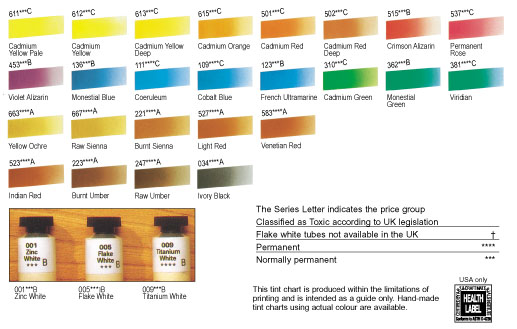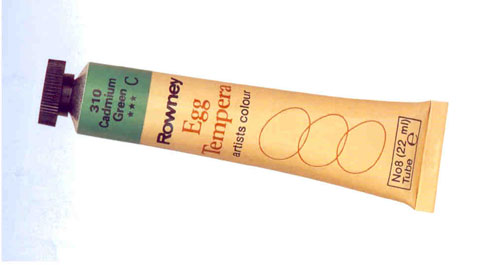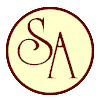
| Egg Tempera Colour Hints and Tips |

Egg Tempera Colour for a traditional look and effect
Click Here to Buy Online Individual Tubes 22 ml Egg Tempera Colour
 |
||
 |
||
|
One of the oldest mediums for fine art painting, dating back to Roman
Egypt and used by most of the Great Masters of the Renaissance. Egg
Tempera imparts pure translucent colour with a distinctive luminosity
and matt satin finish. Today, Daler-Rowney are one of the few artists'
colourmen to offer it ready-mixed in tubes-widely used by professional
art restorers and specialist painters worldwide High quality pigment
is dispersed in liquid egg yolk, according to a formulation dating back
to 1906 The freshness of the colour relies largely on economy of brush
stroke. Thin layers of colour well-diluted with water and carefully
applied in one-stroke washes to a well-planned painting, produce the
wonderful translucent effect associated with the finest egg tempera
paintings. water colour
Source Wikipedia - Tempera (also known as egg tempera, poster color or poster paint) is a type of artist's paint and associated art techniques that were known from the classical world, where it appears to have taken over from encaustic and was the main medium used for panel painting and illuminated manuscripts in the Byzantine world and the Middle Ages in Europe, until it was replaced by oil painting in Europe. It has remained the required medium for Orthodox icons. It is paint made by binding pigment in an egg medium. However, the term tempera in modern times is also used by some manufacturers to refer to ordinary poster paint, which is a form of gouache that has nothing to do with real egg tempera., One might observe simply by washing breakfast dishes that egg yolk dries quickly and adheres firmly. Tempera was traditionally created by hand-grinding dry powdered pigments into egg yolk (which was the primary binding agent or medium), sometimes along with other materials such as honey, water, milk (in the form of casein) and a variety of plant gums. Many of the Fayum mummy portraits use tempera, sometimes in combination with encaustic. Oil paint was invented in the north of Europe during the Middle Ages (Theophilus mentions oil media in the 12th Century) and was the principal medium used from the 15th century in Early Netherlandish painting in northern Europe. Italy, Greece, and Russia were the major centres of tempera painting. Around the year 1500, oil paint replaced tempera in Italy. Tempera continued and continues to be used in Greece and Russia. In the nineteenth and twentieth centuries there were intermittent revivals of tempera technique in Western art, among the Pre-Raphaelites, Social Realists, and others. Tempera paint dries rapidly. The techniques of tempera painting can be more precise when used with traditional techniques that require the application of numerous small brush strokes applied in a cross-hatching technique. The colors, which are painted over each other, resemble a pastel when unvarnished, and are deeper colors when varnished. Tempera is normally applied in thin, semi-opaque or transparent layers. When dry, it produces a smooth matte finish. Because it cannot be applied in thick layers as oil paints can, tempera paintings rarely have the deep color saturation that oil paintings can achieve. On the other hand, tempera colors do not change over time[1], whereas oil paints darken, yellow, and become transparent with age.[2] True tempera paintings are quite permanent, and examples from the first centuries AD still exist, eg the Severan Tondo and some of the Fayum mummy portraits. |
||
|
Pigment Listing for Egg Tempera
Colours Colour Pigments C.I. Names C.I. Numbers Perm. Number
611 Cadmium Yellow Pale Cadmium Zinc Sulphide PY35 77205 *** 612 Cadmium Yellow Cadmium Zinc Sulphide PY35 77205 *** 613 Cadmium Yellow Deep Cadmium Zinc Sulphide / Cadmium Sulphoselenide PY35 / PO20 77205 / 77202 *** 615 Cadmium Orange Cadmium Sulphoselenide PO20 77202 *** 501 Cadmium Red Cadmium Sulphoselenide PR108 77202 *** 502 Cadmium Red Deep Cadmium Sulphoselenide PR108 77202 *** 515 Crimson Alizarin Lake PR83:1 58000:1 *** 537 Permanent Rose Quinacridone PV19 73900 *** 453 Violet Alizarin Quinacridone & Dioxazine Purple PV19/ PV23 73900/ 51319 *** 136 Monestial Blue (Phthalo) Phthalo Blue PB15 74160 *** 111 Coeruleum Cobalt Stannate PB35 77368 **** 109 Cobalt Blue Cobalt Aluminate PB28 77346 **** 123 French Ultramarine Blue PB29 77007 *** 310 Cadmium Green Hydrated Chromium Oxide & Cadmium Zinc Sulphide PG18/ PY35 77289/ 77205 *** 362 Monestial Green (Phthalo) Phthalo Green PG7 74260 *** 381 Viridian Hydrated Chromium Oxide PG18 77289 **** 663 Yellow Ochre Natural Yellow Iron Oxide PY42 77492 **** 667 Raw Sienna Natural Iron Oxide PY42 77492 **** 221 Burnt Sienna Natural Iron Oxide & Quinacridone PBr7 / PO49 77491 / 73920 **** 527 Light Red Iron Oxide / Yellow Iron oxide PR101 / PY 42 77491 / 77492 **** 583 Venetian Red Iron Oxide PR101 77491 **** 523 Indian Red Iron Oxide PR101 77491 **** 223 Burnt Umber Natural Iron Oxide PBr7 77491 **** 247 Raw Umber Natural Iron Oxide PBr7 77491 **** 034 Ivory Black Bone Black PBk9 77267 **** 001 Zinc White Zinc Oxide PW4 77947 **** 005 Flake White Basic Lead Carbonate & Titanium Dioxide PW1/ PW6 77597/ 77891 *** |
|
Click Here to Buy Online Individual Tubes 22 ml Egg Tempera Colour |
Studio Arts Shop for Online Discounts

50 North Road Lancaster
England LA1 1LT Tel:
+44 (0)1524 68014
Copyright © Studio
Arts. All Rights Reserved.